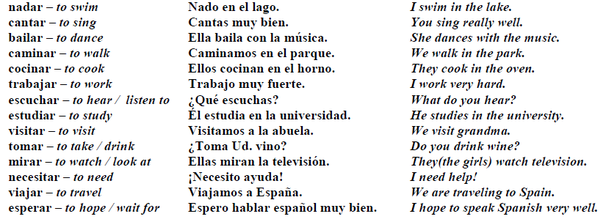

You can access any of the individual pages via the links on the page groupings above for each month.
#Ar ending verbs in spanish full
Viewing the Full Conjugations of the Verbs in the Spanish Verb ListĪll the verb tables in this Spanish Lesson List of Verbs appear in the Daily Spanish Lesson page. This super simple tool and technique will consolidate the effectiveness of your learning by a factor of at least two.Ĭheck out also the lesson on the Top Ten Spanish Verbs. letter i gets an accent added and becomes í for present tense and present subjunctive for yo, tú, él, ellos.Īlso you should be sure to check out our secret weapon for verb learning. After LL or ñ and a vowel the letter i is dropped in some tenses G changes to j in the yo present and in subjunctives G changes to j for yo present (yo cojo) and therefore all persons of the present subjunctive and some of the imperatives Spelling change, adding u after g before e Z changes to c before e in yo preterit and in all persons of present subjunctive, and the forms derived from it.



Number of Verbs like this in Spanish (approx) subjunctives: que yo pague, que tú pagues. This also occurs the with the other conjugations that are formed off the first person present indicative - yo pag ué - like the:.To preserve the pronunciation with a 'hard g' (like g in the English word 'go'), the letter 'u' is added after the 'g' to make it spelt yo pag ué.But if written that way, it would be pronounced yo pajé.If the yo preterit was to follow the conjugation rules, 'I paid' would be yo pagé.For example for verbs ending GAR, like pagar. These are usually conjugated in a regular way, but to retain the pronunciation in accordance with the various rules, the spelling has to change. You will notice that some of the verbs just have spelling changes. These verbs are the twenty most common forms of conjugation of Spanish verbs as based on the Bescherelle of Spanish Verbs. Unlike most verb tables, these ones will allow you to build your knowledge with more depth, as you can learn them ROW by ROW (tense by tense), as well as COLUMN by COLUMN (pronoun by pronoun). Reciting each verb table aloud will take about three or four minutes. The next months follow the AR-ER-IR, so that each month you will look at a new family, with each group rotating through the AR-ER-IR groupings. March covers another family - the ER verbs, April is IR. So for the months of January and February you will cover a particular family of verbs - the AR verbs. The Verb Tables are grouped by month and one automatically appears on our DAILY SPANISH LESSON page. A few minutes a day for 30 days and you can conquer various families of verb endings and conjugations with our powerful verb tables. This SPANISH VERB LIST groups various Spanish verbs according their family of endings. As for the second exercise, students must complete the sentences using the right conjugation for each -AR regular verbs in Spanish in parentheses.SPANISH VERB LIST - Conquer the Verb Families Please review t he lesson on this topic on our website before working on this worksheet. The first one (AMAR – to love) has already been conjugated, so all they need to do is conjugate the remaining nine verbs following the same pattern. There are 10 very important -AR regular verbs in Spanish in the box. Students could work individually or in pairs to solve the exercises on this worksheet.įirstly, this worksheet presents a short definition of regular verbs in Spanish, that is verbs that follow specific conjugation rules depending on their ending. Hopefully, the exercises in this worksheet will help you reinforce your knowledge on this topic. This time, we will focus on practicing the conjugation rules for -AR regular verbs in Spanish in the present tense. ¡Hola! Today, we will be sharing a grammar worksheet on a very important topic in the language: regular verbs in Spanish.


 0 kommentar(er)
0 kommentar(er)
